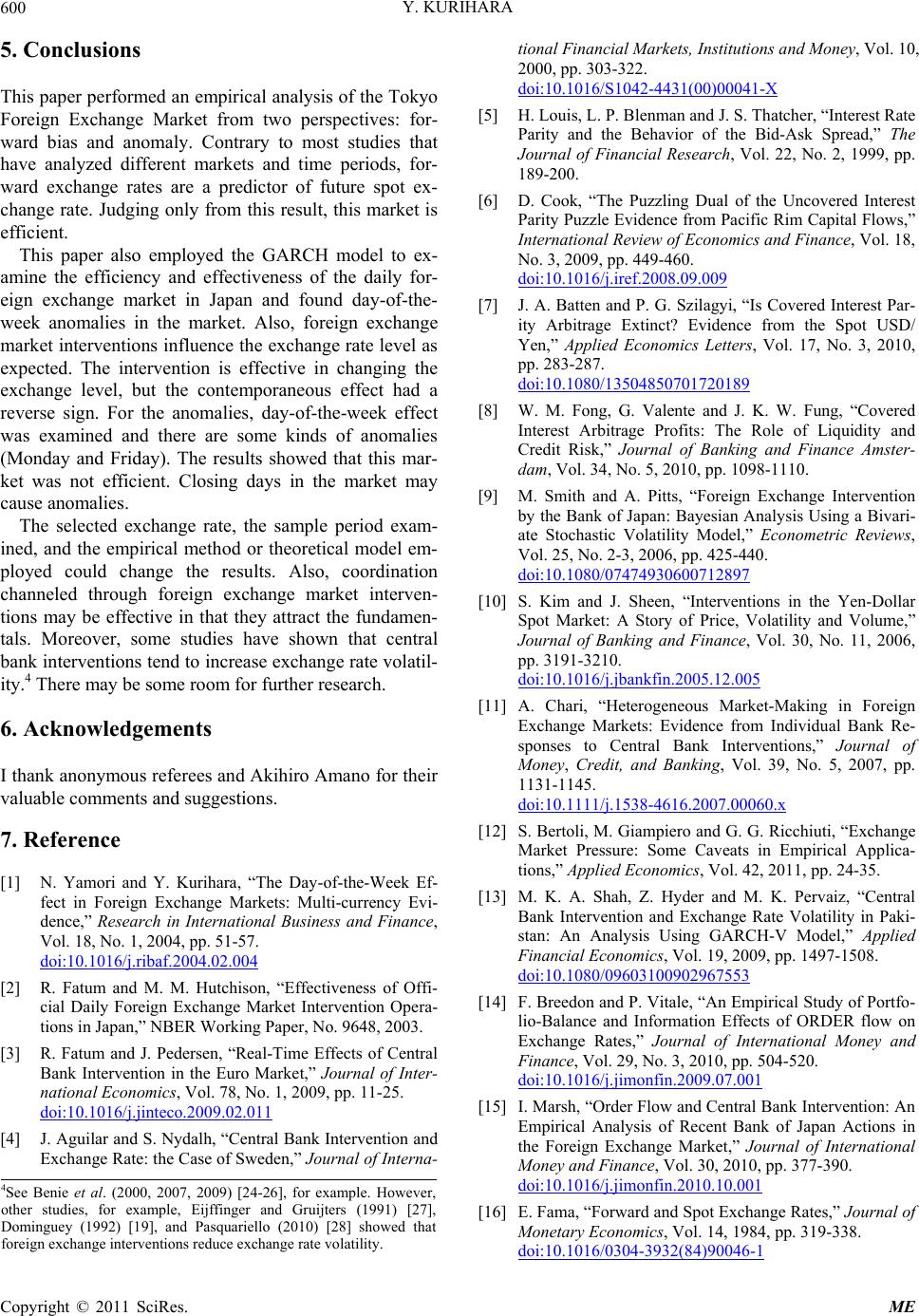
Y. KURIHARA
600
5. Conclusions
This paper performed an empirical analysis of the Tokyo
Foreign Exchange Market from two perspectives: for-
ward bias and anomaly. Contrary to most studies that
have analyzed different markets and time periods, for-
ward exchange rates are a predictor of future spot ex-
change rate. Judging only from this result, this market is
efficient.
This paper also employed the GARCH model to ex-
amine the efficiency and effectiveness of the daily for-
eign exchange market in Japan and found day-of-the-
week anomalies in the market. Also, foreign exchange
market interventio ns influence the exchange rate level as
expected. The intervention is effective in changing the
exchange level, but the contemporaneous effect had a
reverse sign. For the anomalies, day-of-the-week effect
was examined and there are some kinds of anomalies
(Monday and Friday). The results showed that this mar-
ket was not efficient. Closing days in the market may
cause anomalies.
The selected exchange rate, the sample period exam-
ined, and the empirical method or theoretical model em-
ployed could change the results. Also, coordination
channeled through foreign exchange market interven-
tions may be effective in that they attract the fundamen-
tals. Moreover, some studies have shown that central
bank interven tions tend to in crease exchange rate volatil-
ity.4 There may be some room for further research.
6. Acknowledgements
I thank anonymous referees and Akihiro Amano for their
valuab le comments and suggestio ns.
7. Reference
[1] N. Yamori and Y. Kurihara, “The Day-of-the-Week Ef-
fect in Foreign Exchange Markets: Multi-currency Evi-
dence,” Research in International Business and Finance,
Vol. 18, No. 1, 2004, pp. 51-57.
doi:10.1016/j.ribaf.2004.02.004
[2] R. Fatum and M. M. Hutchison, “Effectiveness of Offi-
cial Daily Foreign Exchange Market Intervention Opera-
tions in Japan,” NBER Working Paper, No. 9648, 2003.
[3] R. Fatum and J. Pedersen, “Real-Time Effects of Central
Bank Intervention in the Euro Market,” Journal of Inter-
national Econo m i c s, Vol. 78, No. 1, 2009, pp. 11-25.
doi:10.1016/j.jinteco.2009.02.011
[4] J. Aguilar and S. Nydalh, “Central Bank Intervention and
Exchange Rate: the Case of Sweden,” Journal of Interna-
tional Financial Markets, Institutions and Money, Vol. 10,
2000, pp. 303-322.
doi:10.1016/S1042-4431(00)00041-X
[5] H. Louis, L. P. Blenman and J. S. Thatcher, “Interest Rate
Parity and the Behavior of the Bid-Ask Spread,” The
Journal of Financial Research, Vol. 22, No. 2, 1999, pp.
189-200.
[6] D. Cook, “The Puzzling Dual of the Uncovered Interest
Parity Puzzle Evidence from Pacific Rim Capital Flows,”
International Review of Economics and Finance, Vol. 18,
No. 3, 2009, pp. 449-460.
doi:10.1016/j.iref.2008.09.009
[7] J. A. Batten and P. G. Szilagyi, “Is Covered Interest Par-
ity Arbitrage Extinct? Evidence from the Spot USD/
Yen,” Applied Economics Letters, Vol. 17, No. 3, 2010,
pp. 283-287.
doi:10.1080/13504850701720189
[8] W. M. Fong, G. Valente and J. K. W. Fung, “Covered
Interest Arbitrage Profits: The Role of Liquidity and
Credit Risk,” Journal of Banking and Finance Amster-
dam, Vol. 34, No. 5, 2010, pp. 1098-1110.
[9] M. Smith and A. Pitts, “Foreign Exchange Intervention
by the Bank of Japan: Bayesian Analysis Using a Bivari-
ate Stochastic Volatility Model,” Econometric Reviews,
Vol. 25, No. 2-3, 2006, pp. 425-440.
doi:10.1080/07474930600712897
[10] S. Kim and J. Sheen, “Interventions in the Yen-Dollar
Spot Market: A Story of Price, Volatility and Volume,”
Journal of Banking and Finance, Vol. 30, No. 11, 2006,
pp. 3191-3210.
doi:10.1016/j.jbankfin.2005.12.005
[11] A. Chari, “Heterogeneous Market-Making in Foreign
Exchange Markets: Evidence from Individual Bank Re-
sponses to Central Bank Interventions,” Journal of
Money, Credit, and Banking, Vol. 39, No. 5, 2007, pp.
1131-1145.
doi:10.1111/j.1538-4616.2007.00060.x
[12] S. Bertoli, M. Giampiero and G. G. Ricchiuti, “Exchange
Market Pressure: Some Caveats in Empirical Applica-
tions,” Applied Economics, Vol. 42, 2011, pp. 24-35.
[13] M. K. A. Shah, Z. Hyder and M. K. Pervaiz, “Central
Bank Intervention and Exchange Rate Volatility in Paki-
stan: An Analysis Using GARCH-V Model,” Applied
Financial Econo m ic s, Vol. 19, 2009, pp. 1497-1508.
doi:10.1080/09603100902967553
[14] F. Breedon and P. Vitale, “An Empirical Study of Portfo-
lio-Balance and Information Effects of ORDER flow on
Exchange Rates,” Journal of International Money and
Finance, Vol. 29, No. 3, 2010, pp. 504-520.
doi:10.1016/j.jimonfin.2009.07.001
[15] I. Marsh, “Order Flow and Central Bank Intervention: An
Empirical Analysis of Recent Bank of Japan Actions in
the Foreign Exchange Market,” Journal of International
Money and Finance, Vol. 30, 2010, pp. 377-390.
doi:10.1016/j.jimonfin.2010.10.001
4See Benie et al. (2000, 2007, 2009) [24-26], for example. However,
other studies, for example, Eijffinger and Gruijters (1991) [27],
Dominguey (1992) [19], and Pasquariello (2010) [28] showed that
foreign exchange inter ventions reduce exchange rate volatility.
[16] E. Fama, “Forward and Spot Exchange Rates,” Journal of
Monetary Economics, Vol. 14, 1984, pp. 319-338.
doi:10.1016/0304-3932(84)90046-1
Copyright © 2011 SciRes. ME